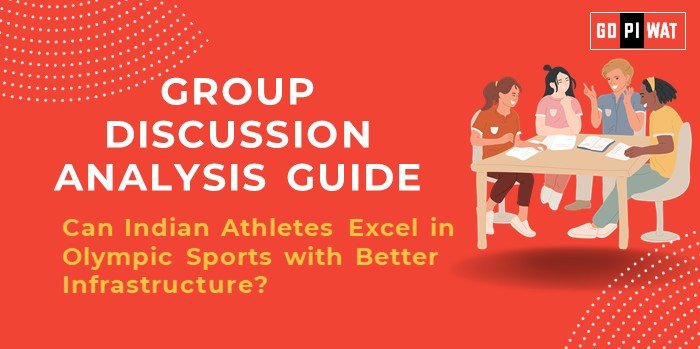📋 Group Discussion (GD) Analysis Guide: Can Indian Athletes Excel in Olympic Sports with Better Infrastructure?
🌐 Introduction to the Topic
The Olympic Games are the pinnacle of global sports, yet India, despite its massive population, has historically underperformed. Improving sports infrastructure could be a game-changer.
With only 35 medals since independence, India’s Olympic journey is a story of unrealized potential. Factors such as inadequate training facilities, lack of grassroots support, and insufficient funding are often cited as barriers.
📊 Quick Facts and Key Statistics
- 🏅 India’s Olympic Medal Tally: 35 since 1947 – a stark contrast to the U.S.’s 3,000+ medals.
- 💰 Sports Budget (2023-24): ₹3,397 crore, with a 20% increase in infrastructure allocation.
- 🎯 Elite Athletes Program: ₹1,250 crore investment for TOPS (Target Olympic Podium Scheme).
- 🌍 Global Comparison: China invested $500 million in sports infrastructure ahead of the 2008 Beijing Olympics, leading to 100+ medals.
🌍 Stakeholders and Their Roles
- 🏛️ Government: Policy-making, funding, and promoting sports at grassroots levels.
- 🏢 Private Sector: Partnerships for infrastructure, sponsorships, and talent scouting.
- 🏆 Sports Authorities: Training and international exposure for athletes.
- 🤾 Athletes and Coaches: Talent development and performance enhancement.
- 🌐 International Organizations: Knowledge-sharing and collaboration.
🏆 Achievements and Challenges
✨ Achievements
- 📈 Increased Funding: A 40% hike in sports budgets in the last decade.
- 🌟 Rise of Champions: Success stories like Neeraj Chopra and PV Sindhu.
- 🎽 Grassroots Programs: Initiatives such as Khelo India improving talent identification.
- 🤝 Public-Private Partnerships: Increased sponsorship and academies like JSW Sports.
⚠️ Challenges
- 🏗️ Infrastructure Gaps: Limited world-class training facilities, especially in rural areas.
- 📂 Administrative Hurdles: Bureaucratic inefficiencies within sports federations.
- 🏃♂️ Talent Retention: High dropout rates among promising athletes.
🌍 Global Comparison
Countries like Australia and the UK transformed their Olympic success with structured investments in sports science and athlete welfare.
💬 Structured Arguments for Discussion
- ✅ Supporting Stance: “With focused investment in world-class facilities, India’s sports talent can achieve global recognition.”
- ❌ Opposing Stance: “Infrastructure alone isn’t enough; systemic issues like governance and talent scouting need urgent reform.”
- ⚖️ Balanced Perspective: “While infrastructure plays a pivotal role, a holistic approach involving governance, athlete welfare, and public support is essential.”
🎯 Effective Discussion Approaches
- 💡 Opening Approaches:
- 📊 Statistical Impact: “India spends only 0.1% of GDP on sports, compared to 0.7% by China.”
- 🌟 Contrast Statement: “India’s medals come at a ratio of 1 medal per 100 million citizens, highlighting untapped potential.”
- 💡 Counter-Argument Handling:
- 📖 Example: “While rural infrastructure is lacking, programs like Khelo India are slowly bridging the gap.”
🔍 Strategic Analysis: SWOT
- 💪 Strengths: Emerging champions, increasing investments.
- 📉 Weaknesses: Bureaucratic inefficiency, lack of sports culture.
- 📈 Opportunities: Hosting global events, leveraging public-private partnerships.
- ⚠️ Threats: Corruption, talent drain, insufficient grassroots outreach.
🎓 Connecting with B-School Applications
- 📌 Real-World Applications: Sports management, sponsorship strategies, and community outreach models.
- 💡 Sample Interview Questions:
- 🤔 “What role can private players have in developing Olympic talent?”
- 🤔 “How can India emulate China’s sports strategy?”
- 📚 Insights for Students:
- 🌟 Exploring sports as an emerging industry.
- 🤝 Learning from public-private partnership models.
- 📊 Analyzing the socio-economic impact of sports.


